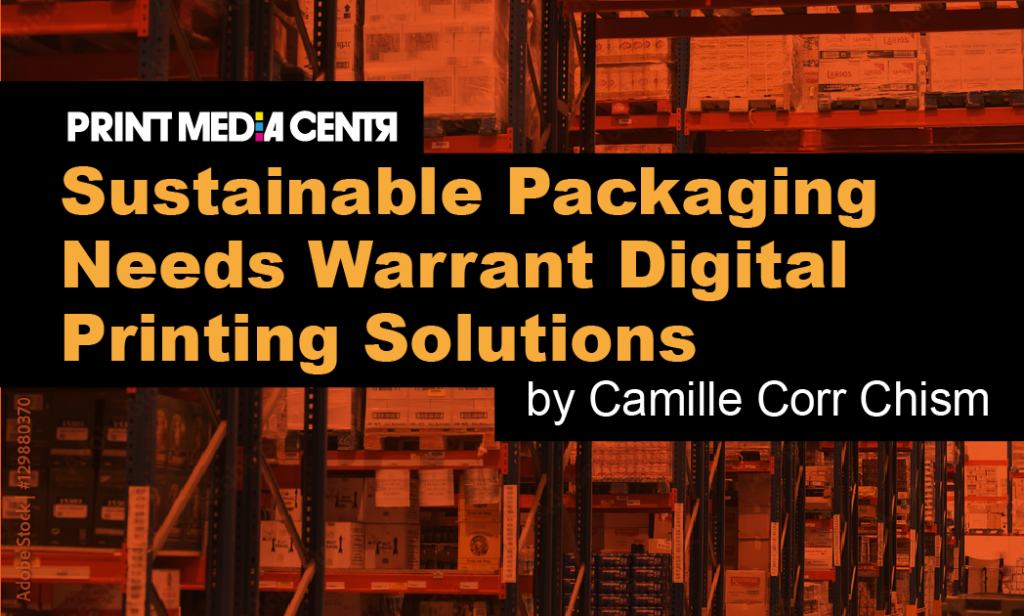
Sustainability is one of the hottest topics in the world of packaging today. Companies proactively seek ways to define sustainability, outline targets, and develop sustainable packaging to meet their objectives.
The packaging industry is predicted to surpass $230 Billion by the year 2030. Meanwhile, companies are pressured to meet sustainability goals. Packaging is very visible, virtually everything has a package, therefore packaging becomes an item consumers pay more attention to, turning to discarded containers as an obvious way to impact sustainability.
Recently, digital printing has taken on a prominent role in many packaging applications. This is directly related to a combination of the drastic increase in shipments ordered online, the demand for customization, as well as the need to better manage worldwide supply chain disruptions with significantly smaller orders. The growing market for digitally printed packaging lends well to flexible orders and digital printing produces less waste. Previously, traditional print methods required large and uniform production volumes. Changeover and startup processes in traditional print processes automatically generate waste in material, ink, and energy.
Corporate sustainability initiatives are being driven by global climate change. Packaging gained more visibility because it is a visible and prominent component in the massive amount of waste discarded across the globe. The pandemic of 2020 led to an increase in direct shipments as consumers began sheltering in place and ordering home shipments. At the same time, companies realized that customized products and subscription boxes drove higher sales. These factors made it possible to successfully incorporate digital print for various packaging platforms.
Leveraging digital printing has numerous advantages related to sustainable packaging. Because of the shorter print runs and less waste, it is possible to decrease excess material, ultimately reducing landfill volumes. Digital printing reduces or eliminates some chemicals, energy, and emissions required to produce mass print production runs. Smaller runs mean rightsizing orders for production, reduced transport, and lower space requirements for warehousing and storage of materials, plates, and dies. Ultimately, the carbon footprint can be reduced and the amount can be quantified in the calculations and metrics.
Material selection decisions can be made for inks, substrates, coatings, and adhesives that impact sustainability. Cans and bottles can be printed directly, eliminating non-recyclable sleeves, thus making the packaging fully recyclable. Cartons can be made from recycled materials, or pulp sourced and run from sustainable sources with direct digital print, improving recycling efficiency by avoiding labels and stickies derived from label adhesives. Bags can be printed to order without labels and in smaller quantities. Corrugated boxes widely used for subscription boxes are more customized than the average corrugated box. The contents of the subscriptions change regularly, and customers enjoy receiving packaging with special messages or information related to the environmental impact of their packaging.
Let’s look at some characteristics of packaging that leverage digital printing and impact sustainability. Substrate selection can determine the type of material used, the amount of material, the design of packaging, and what the life cycle of the pack will be. Selecting a packaging substrate that can be digitally printed is significant because the design can focus on reduction. The amount of material, energy, and emissions used to manufacture the pack and the weight or volume of the final design can be planned to intentionally minimize the amount of material used in the design or, go to landfills at the end of life.
Materials can be incorporated to maximize the recycled content. Packaging can be planned for viable recycling, composting, or reusability, especially as digital print allows for more effective recycling without extra labels, adhesives, and multiple materials.
Over the next week, take note of the packaging you receive and use. Comment and let the Printerverse know what you uncover!
Can you determine if the packaging is digitally printed or if it could have been digitally printed if it is not? Also, note whether the packaging you analyze has been intentionally designed for sustainability. Here are some factors to look for:
Waste
- Can the MOQ (minimum order quantity) be reduced or eliminated?
- Is it possible to determine what emissions or toxins are used or eliminated in the manufacturing process?
- Does the packaging use excessive material or intentionally eliminate multiple layers and unnecessary mixed materials in the packaging?
Raw materials
- Can the substrates, inks, and coatings selected incorporate a digital print format?
- Does the process to obtain and process raw materials minimize or avoid deforestation or depletion of natural resources such as sand, aluminum, petroleum, etc.?
Energy
- Do the packaging choices inadvertently use more energy resources in hidden processes, for example, electricity or fossil fuels, versus renewable energy in any of the processes used to convert materials?
Emissions
- Is the packaging made for precise production volumes that minimize the use of fuel for transit or manufacturing?
##
Read last month’s post from Camille: https://printmediacentr.com/paper-shortages-and-the-impact-of-digital-print-in-packaging
See all posts from Camille here.
 Camille Corr Chism, CPPL Fellow, has a diverse background in packaging engineering, design, supply chain, project management, and new product introductions. Her experience includes a variety of industries including food, e-commerce, technology, distribution, pharmaceutical, industrial, and automotive. Earning an MS and BS in Packaging, Camille earned a Six Sigma Black Belt (2019), and a lifetime certification as a Certified Packaging Professional in 2006. She was inducted into the IoPP College of Fellows in 2014.
Camille Corr Chism, CPPL Fellow, has a diverse background in packaging engineering, design, supply chain, project management, and new product introductions. Her experience includes a variety of industries including food, e-commerce, technology, distribution, pharmaceutical, industrial, and automotive. Earning an MS and BS in Packaging, Camille earned a Six Sigma Black Belt (2019), and a lifetime certification as a Certified Packaging Professional in 2006. She was inducted into the IoPP College of Fellows in 2014.
Camille is the owner of Indigo Packaging and Consulting. She is the go-to person for all your packaging products and packaging design needs. Connect with her on LinkedIn, LinkedIn Company Page, Twitter @indigopkg, and Instagram @indigopkg











